ikfoundation.org
The IK Foundation
Promoting Natural & Cultural History
Since 1988


SEASIDE FASHION AND BATHING SUITS
– In Whitby along the North Sea Coast: 1880s to 1914
During both Victorian and Edwardian times, loose-fitting swimwear – named bathing suits or costumes – were still worn only for actually entering the sea and were designed to be put on in a ‘bathing machine’ that had been dragged halfway into the water. According to contemporary photographs, it is evident that all those remaining on the beach were still fully dressed in their everyday clothes. Pictures of the coast at Whitby show mobile bathing machines that horses could pull backwards and forwards, as well as ‘Bathing tents for hire,’ which were possible to change for swimming. This case study will look closely at a selection of such seaside photographs. Together with two preserved bathing costumes at the local museum and contemporary advertisements, they reveal many connections to seaside leisure and textile novelties for the period.
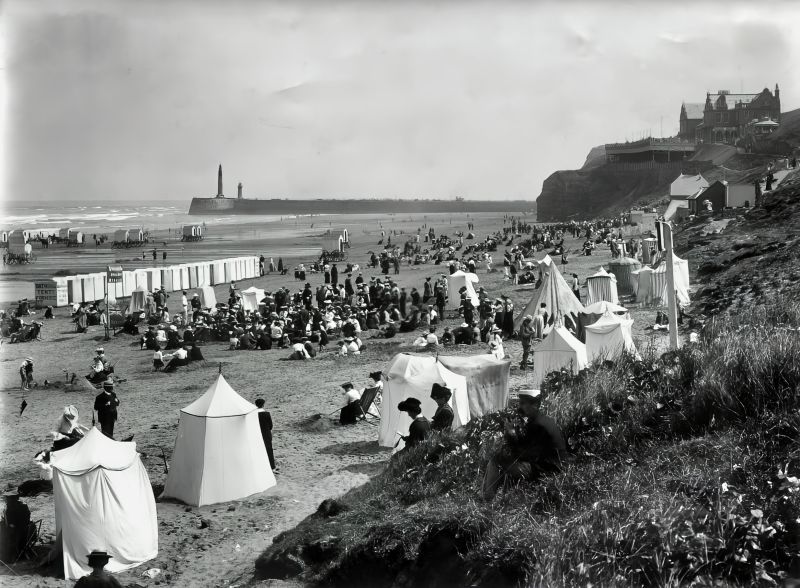 In the picture are bathing tents and bathing huts for hire during Edwardian times at Whitby Beach. The photo taken by the professional local photographer Tom Watson (1863-1957) also shows the considerable effort required to move the bathing huts backwards and forwards with the assistance of horses, in order to keep pace with the ebb and flow of the tide. Photographs like this one – taken by professional or amateur photographers alike – often show women’s large hats, white blouses, belted waists, simple long skirts and white parasols, which were the typical seaside fashion at the time. (Courtesy: Whitby Museum, Photographic Collection, LIB 487).
In the picture are bathing tents and bathing huts for hire during Edwardian times at Whitby Beach. The photo taken by the professional local photographer Tom Watson (1863-1957) also shows the considerable effort required to move the bathing huts backwards and forwards with the assistance of horses, in order to keep pace with the ebb and flow of the tide. Photographs like this one – taken by professional or amateur photographers alike – often show women’s large hats, white blouses, belted waists, simple long skirts and white parasols, which were the typical seaside fashion at the time. (Courtesy: Whitby Museum, Photographic Collection, LIB 487).
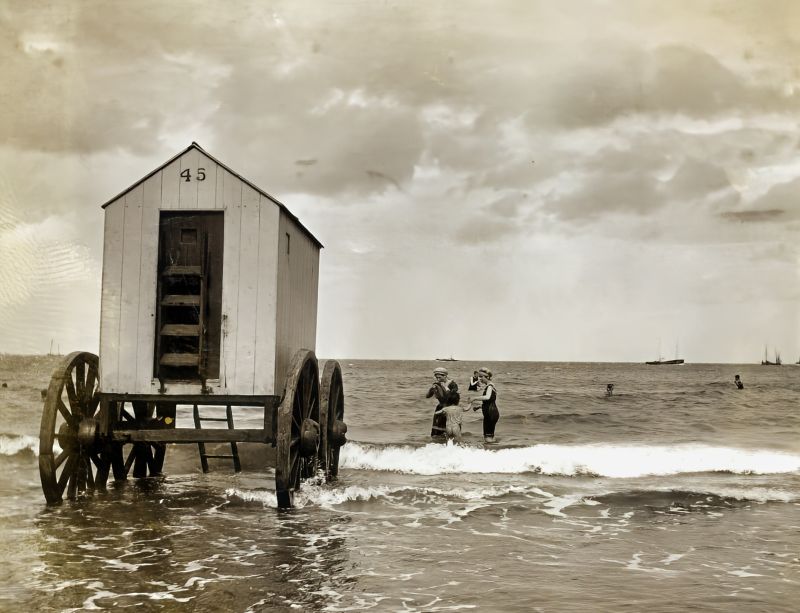 This photograph of bathing hut ’45’ also depicts women, men and children in bathing costumes at Whitby beach, circa 1900-1910. (Courtesy: Whitby Museum, Photographic Collection, C533, part of photo. Unknown photographer).
This photograph of bathing hut ’45’ also depicts women, men and children in bathing costumes at Whitby beach, circa 1900-1910. (Courtesy: Whitby Museum, Photographic Collection, C533, part of photo. Unknown photographer).Seaside photography around the year 1900 had the advantage of often allowing for a relaxed atmosphere, without strict arrangements, to convey a natural impression to the viewer. As the number of visiting holiday-makers increased over the years in this seaside town, a need for entertainment of various kinds also developed, like concerts and outdoor theatres. Even if larger groups of society were in the position to enjoy a summer Sunday at the beach in late Victorian and Edwardian times than in earlier years, those who sewed, sold fabric and clothes and washed these delicate garments seldom appeared in these photographs taken on the shore, round the Pavilion or walking in the West Cliff area. Despite the popularity of the town as a seaside resort, the Whitby Museum's Costume collection only possesses two bathing costumes, in wool and cotton, respectively, with details of the fabric qualities illustrated in the two images below.
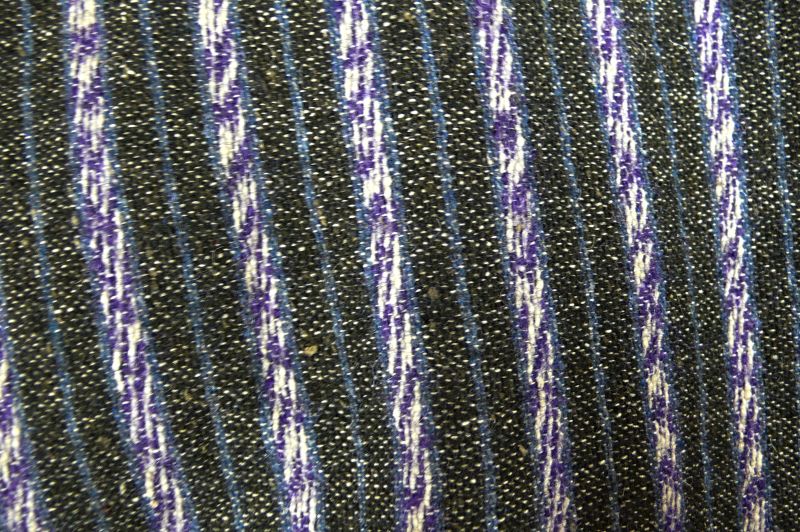 This close-up image of the first bathing costume was machine-sewn from a strong, coarse woollen material with narrow stripes and would have fitted an older child in the late Victorian period. Apart from the fact that this woollen outfit must have been highly prickly to the skin, it must also have been heavy and awkward in the water. (Collection: Whitby Museum, Costume Collection, GBD 110). Photo: Viveka Hansen, The IK Foundation.
This close-up image of the first bathing costume was machine-sewn from a strong, coarse woollen material with narrow stripes and would have fitted an older child in the late Victorian period. Apart from the fact that this woollen outfit must have been highly prickly to the skin, it must also have been heavy and awkward in the water. (Collection: Whitby Museum, Costume Collection, GBD 110). Photo: Viveka Hansen, The IK Foundation.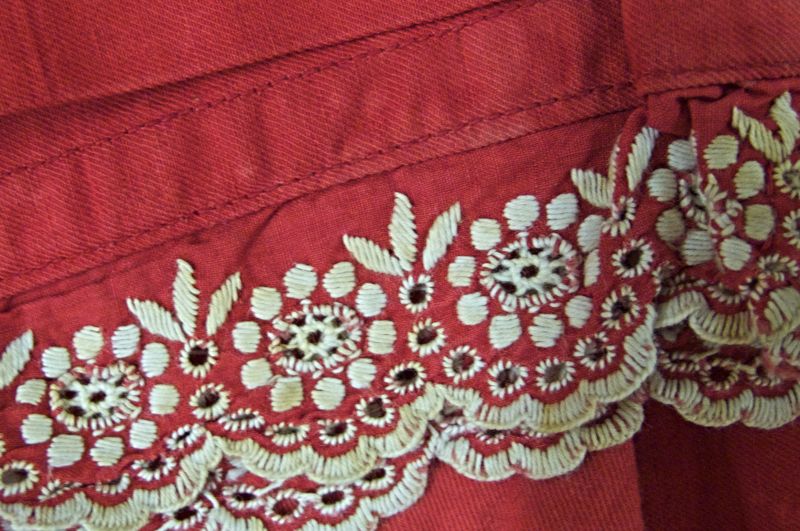 Detail of embroidery on an Edwardian bathing costume. This second loose-fitted garment is of somewhat later date – about 1900 to 1910 – machine-sewn in red cotton with short sleeves and bloomers reaching down to the calf, a typical style of the period for women, fastened with white cloth buttons in front and wearable with the addition of a matching belt around the waist. The garment has been marked ‘R. Longland’ on a sewn-in cotton label and has a machine-embroidered decorative border in contrasting white. (Collection: Whitby Museum, Costume Collection, GBD 108). Photo: Viveka Hansen, The IK Foundation.
Detail of embroidery on an Edwardian bathing costume. This second loose-fitted garment is of somewhat later date – about 1900 to 1910 – machine-sewn in red cotton with short sleeves and bloomers reaching down to the calf, a typical style of the period for women, fastened with white cloth buttons in front and wearable with the addition of a matching belt around the waist. The garment has been marked ‘R. Longland’ on a sewn-in cotton label and has a machine-embroidered decorative border in contrasting white. (Collection: Whitby Museum, Costume Collection, GBD 108). Photo: Viveka Hansen, The IK Foundation.It can be supposed that many of the customers at draperies and other similar shops were in Whitby as visitors during the summer months only and needed to supplement their wardrobes with garments suitable for sun, beach and leisure. A selection of advertisements in the local Whitby Gazette during the period and Horne’s Guide to Whitby from 1897 will exemplify fashionable or practical garments as well as desirable novelties for various uses.
The drapers Wellburn Brothers of Bridge Street (1857-1914) placed small advertisements regularly, either to announce a new item available, a large stock of a particular product or a sale at reduced prices. On 14 May 1897, they advertised a new fabric for clothes: ‘The New Material for Ladies & Children Day and Night Wear is VIYELLA (Unshrinkable)... Sole Agents for Whitby’. Viyella was seen as a revolutionary invention since it was the first fabricated fibre. The material was of English manufacture and was first produced in 1893, with 55% merino wool mixed with 45% cotton fibre to make a light but warm twill cloth. A material that must have been useful during the holiday season along the North Sea coast, where many summer days stay moderately warm or even chilly. Another draper was Henry Duck, who had his shop on Flowergate (1862-1914). In August 1899, for instance, he advertised in the same local newspaper about a novelty: ‘The C.B. Corsets can be obtained in Greatest Variety Locally’. This type of corset, elegantly shaped to the body with special forms for the bust and hips, was made by Charles Boyer and reached its greatest popularity around the turn of the century. Even in many beach photographs, it is evident that women preferred to wear corsets, just as they did everywhere else, to ensure their garments fit as intended – according to the fashion style of their time. Whilst a newcomer in Baxtergate was David Hume (1895-1909), who had earlier worked for the cash-drapers R. Gray & Co. Hume regularly advertised till 1909, concentrating mainly on ladies’ clothes and accessories; for example, on 25 August 1899, he had on offer a ‘Surplus Stock of Mantles, Jackets, Capes, Coats & Skirts... Remaining Stock of Blouses, Shirts, Ties, Collars, Fichus, Ostrich Feather Boas, Sunshades, Skirts, Sun hats & Bonnets, Millinery, &c. All specially reduced.’ Meanwhile, Mrs Atkinson, who ran her business from Sandringham House, 6 & 8 Skinner Street (1896-1914), announced in May of her first year ‘Mrs Atkinson’s Show of Summer Fashions in the Latest London and Paris Styles on Tuesday, Wednesday and Thursday.’
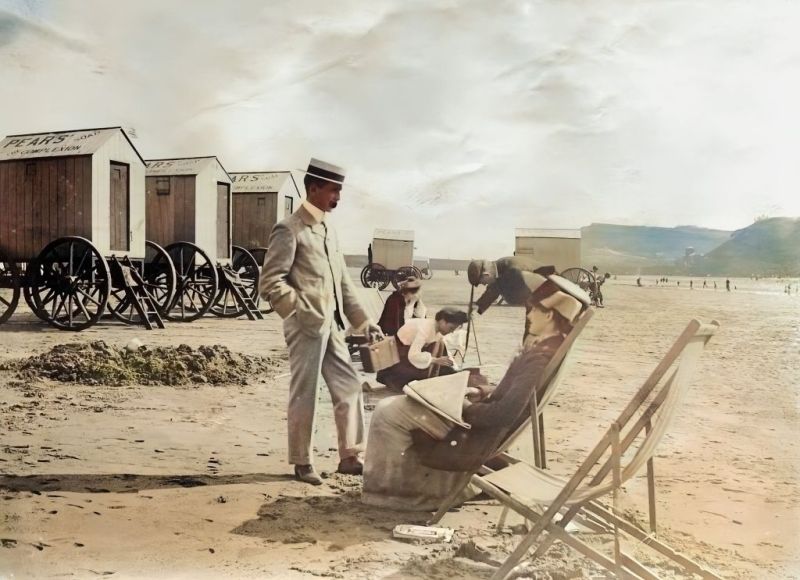 Man in a light-coloured tailored suit and straw boater hat, appropriate beach dress for c.1905-1910. In company with a lady comfortably seated in a deckchair with her newspaper. The couple had chosen to carry their chairs quite a bit from the cliffside at this ebb phase; maybe they were planning to change into bathing suits in one of the bathing machines when the water flowed in. Overall, the popularity of this stretch of beach is not only its beauty and vicinity of the town’s facilities but also that even if the difference between the ebb and flow of the tide can be up to five and a half meters in Whitby, there is always at least a small narrow piece of dry land even at the highest tide. (Courtesy: Whitby Museum, Photographic Collection, C466 & added modern digital colouring. Unknown photographer).
Man in a light-coloured tailored suit and straw boater hat, appropriate beach dress for c.1905-1910. In company with a lady comfortably seated in a deckchair with her newspaper. The couple had chosen to carry their chairs quite a bit from the cliffside at this ebb phase; maybe they were planning to change into bathing suits in one of the bathing machines when the water flowed in. Overall, the popularity of this stretch of beach is not only its beauty and vicinity of the town’s facilities but also that even if the difference between the ebb and flow of the tide can be up to five and a half meters in Whitby, there is always at least a small narrow piece of dry land even at the highest tide. (Courtesy: Whitby Museum, Photographic Collection, C466 & added modern digital colouring. Unknown photographer).During the years 1895 to 1897, John T. Stewart Tailor and Woollen Draper offered their services via advertisements in the local newspaper. In the first year, he announced that he had moved from no.14 Flowergate to continue his business at no.34 in the same street, which had been ‘lately occupied by Mr Spanton’. Another advertisement a year later makes it clear that he sold clothes of particular interest to the modern person interested in sport and hunting: ‘Riding Habits, Cycling, Golf, and Shooting Costumes’. The same theme was repeated in Horne’s Guide to Whitby from 1897, which included several examples of advertising by local drapers, one of them was the tailor and draper James N. Clarkson & Son (1855-1907), who addressed themselves above all to the modern tourist, offering clothes suitable ‘For Seaside, Travelling, Yachting, Cycling, and Golfing...’. Another tailor and draper, Edmund Crane’s establishment in Bridge Street (1855-1914), changed its name in 1893 to E. Crane & Co. They advertised frequently until 1899 and then stopped for a while to resume frequent advertising in 1909-1914. For example, in the spring of 1897, the recent novelty ‘Cycling Costumes’, which had featured in Crane’s advertisement. Despite repeated advertising for suitable clothing, cycling never seems to have been a popular pastime or means of transportation in the area at this time, most likely due to the very steep hills of the town and its surroundings. Whilst the long-lived popular seaside holiday in Whitby with entertainment at the beach, bathing machines, and people in pretty light-coloured summer clothes and wide hats came to an abrupt end in 1914 with the outbreak of war.
Sources:
- Hannavy, John, The English Seaside in Victorian and Edwardian Times, Oxford 2008.
- Hansen, Viveka, The Textile History of Whitby 1700-1914 – A lively coastal town between the North Sea and North York Moors, London & Whitby 2015 (pp. 29-30, 111-115, 227 & 253-254).
- Horne’s Guide to Whitby, Whitby 1897.
- Whitby Gazette, 1855-1914.
- Whitby Museum (Whitby Lit. & Phil.), Whitby, United Kingdom. | Costume Collection (Two bathing suits/costumes). | Library & Archive (Whitby Gazette, original papers). | Photographic Collection (Local photographs 1880s-1914). | Research made during the years 2006-2012.
More in Books & Art:
Essays
The iTEXTILIS is a division of The IK Workshop Society – a global and unique forum for all those interested in Natural & Cultural History from a textile Perspective.
Open Access essays, licensed under Creative Commons and freely accessible, by Textile historian Viveka Hansen, aim to integrate her current research, printed monographs, and earlier projects dating back to the late 1980s. Some essays feature rare archive material originally published in other languages, now available in English for the first time, revealing aspects of history that were previously little known outside northern European countries. Her work also explores various topics, including the textile trade, material culture, cloth manufacturing, fashion, natural dyeing, and the intriguing world of early travelling naturalists – such as the "Linnaean network" – viewed through a global historical lens.
For regular updates and to fully utilise iTEXTILIS' features, we recommend subscribing to our newsletter, iMESSENGER.
been copied to your clipboard




– a truly European organisation since 1988
Legal issues | Forget me | and much more...
You are welcome to use the information and knowledge from
The IK Workshop Society, as long as you follow a few simple rules.
LEARN MORE & I AGREE







